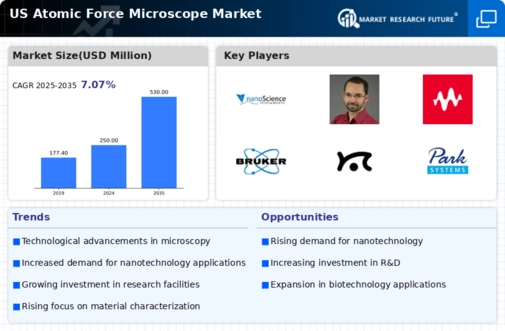Advancements in Imaging Techniques
Advancements in imaging techniques significantly influence the atomic force-microscope market. Continuous innovations in AFM technology enhance imaging resolution and speed, making it more accessible for various applications. These improvements allow researchers to obtain high-quality images of surfaces and materials, which is crucial for both academic and industrial applications. In 2025, the market for advanced imaging technologies is expected to grow by 15%, indicating a strong trend towards adopting cutting-edge tools like atomic force microscopy. The ongoing development of new imaging modalities positions atomic force microscopy as a leading choice for researchers seeking to push the boundaries of material characterization.
Increased Focus on Quality Control
Quality control remains a pivotal driver for the atomic force-microscope market, particularly in industries such as pharmaceuticals and biotechnology. The need for stringent quality assurance processes compels manufacturers to adopt advanced analytical techniques, including atomic force microscopy. This technology allows for the detailed examination of product surfaces, ensuring compliance with regulatory standards. In 2025, the pharmaceutical sector is projected to allocate over $50 billion towards quality control measures, thereby fostering the growth of the atomic force-microscope market. The ability to detect surface irregularities and defects enhances product reliability, making atomic force microscopy a critical component in quality assurance protocols.
Growth in Material Science Research
The atomic force-microscope market benefits significantly from the expansion of material science research. As researchers delve into the properties of new materials, the demand for high-resolution imaging and analysis tools increases. Atomic force microscopy provides unparalleled insights into material properties, enabling scientists to explore nanostructures and their applications in various fields, including energy storage and biomaterials. In 2025, funding for material science research in the US is expected to reach $10 billion, indicating a robust growth trajectory. This influx of investment is likely to enhance the adoption of atomic force microscopy, solidifying its role in advancing material science.
Emerging Applications in Life Sciences
the market is poised for growth due to emerging applications in life sciences.. As the healthcare sector increasingly adopts nanotechnology for drug delivery and diagnostics, atomic force microscopy plays a vital role in characterizing biological samples at the nanoscale. This technology facilitates the study of cellular interactions and biomolecular structures, which are essential for developing innovative therapeutic strategies. In 2025, the life sciences market is anticipated to exceed $200 billion in the US, creating substantial opportunities for atomic force microscopy. The integration of this technology into life sciences research underscores its importance in advancing medical science.
Rising Demand in Semiconductor Industry
The atomic force-microscope market experiences a notable surge in demand driven by the semiconductor industry. As the need for advanced semiconductor devices escalates, manufacturers increasingly rely on atomic force microscopy for precise characterization and quality control. This technology enables the analysis of surface topography at the nanoscale, which is crucial for the development of smaller, more efficient chips. In 2025, the semiconductor sector is projected to contribute approximately $500 billion to the US economy, further propelling the atomic force-microscope market. The ability to enhance device performance and reliability through meticulous surface analysis positions atomic force microscopy as an indispensable tool in semiconductor fabrication.



















Leave a Comment